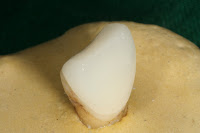This work was carried out by Dr Shantanu Jambhekar and me. A special thanks to him.
Introduction of osseointegrated implants has changed the way partially and completely edentulous patients
can be treated. Although the reported success rates are high, implant treatments are not entirely risk free and may
result in a range of reversible and irreversible complications.
Restorations supported by implants can be either cement retained or screw retained.
prostheses have gained preference in many cases, making them the restoration of choice for the treatment of implant
patients.
3 Cement-retained
One of the drawbacks of cement retained restorations is extrusion of excess cements into the peri-implant
sulcus with subsequent complications.
The soft tissue attachment onto the implant surface is more delicate than that seen at the natural tooth surface
due to the lack of Sharpey
fibers run.
’s fiber insertion, the reduced number of collagen fibers, and the direction in which these
Both the detection and the subsequent removal of the excess cement are significantly complicated by the
depth of the gingival sulcus and by the contours of the abutment and the implant crown.
Several methods are used to prevent cement-related complications for cement-retained prostheses.
Placement of the abutment collar margin should be just apical to the gingival crest in the esthetic zone and at the
gingival crest or slightly occlusal elsewhere to allow unimpeded ability of cement to escape coronally. A lingual
escape hole can also be used to provide an escape route for the cement.
Control of cement volume has been documented previously using the ITI solid abutment (Straumann USA,
Andover, Mass).This requires an implant analog or practice abutment, as described by the authors. When a custom
abutment is to be used under the crown, this becomes more challenging. The dental laboratory may be instructed to
make a duplicate analog using an acrylic resin, but this is time consuming for the technician and involves additional
laboratory costs.
A simple chair side technique to minimize the overflow of cement at the time of cementation by use of a
custom-made abutment replica is described here.
Technique:
1. Evaluate the implant restoration for the fit with the abutment.
2. Attach the abutment to a lab analogue.
[Fig1]-Abutment and lab analogue
3. Line the abutment
with polytetrafluoroethylene (PTFE) tape commonly known as Plumber’s tape or Teflon
tape or TFE (tetrafluoroethylene) threaded seal tape which provides a space of approximately
[Fig2]-Lining of abutment with Plumbers tape) and the catalyst and using an applicator with a smaller diameter tip, completely fill the implant
4. Seat the implant restoration completely onto the abutment to facilitate the transfer of the tape to the intaglio
surface of the implant restoration.
[Fig3]-Transfer of tape to intaglio surface
5. Mix small amount of condensation silicone putty(Zhermack C-Silicones Zetaplus - Putty Impression
Material
restoration and form a handle.
[Fig4]-Forming a handle with putty
6. Remove the putty material along with the PTFE and compare the implant abutment to the putty model;
ensure that no voids are present and that the abutment finish line has been accurately duplicated .This is the abutment replica.
[Fig 5]-Abutment replica
7. Place the abutment intraorally. Torque it in place and block the access holes.
[Fig6]-Abutment intraorally
8. Use the luting agent of choice line the intaglio of the implant restoration. Place the crown onto theabutment replica and wipe off the excess cement immediately.
[Fig7]-Excess cement present in the crown
9. While the cements is still fluid, remove the crown from the abutment replica (there will be a layer of
residual cement on the abutment replica), and add a thin layer of cement in the intaglio of the
restoration.
[Fig.8]-Residual cement on abutment replica
10. Place the implant restoration onto the implant abutment intraorally. There will be little or no excess cement
thus minimizing the amount of excess cement extruded into peri-implant tissues.
  |
| [Fig 9,10 - Post cementation) |























